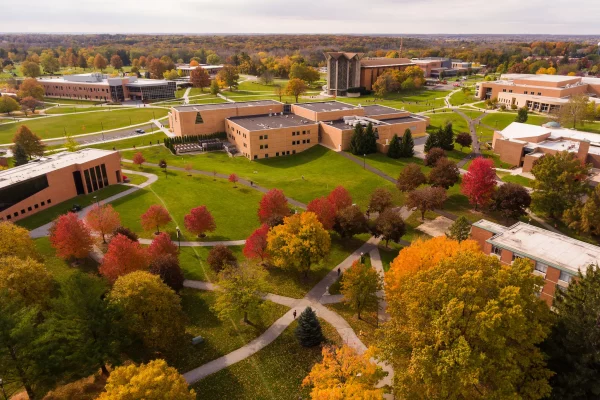Exciting First Steps Towards More Efficient Solar Power

Serving as Beacons of stewardship for the environment and moving the campus toward more environmentally-friendly operations are both features of Valparaiso University’s Uplift Valpo: Our Beacon for the Journey Forward strategic plan, as are the values of leadership and service. One project embodying all of these values is a series of tests being undertaken at the James S. Markiewicz Solar Energy Research Facility (SERF) aimed at improving our ability to effectively store solar energy. The project is under the Pennsylvania-based company Advanced Cooling Technologies and is being funded by a Small Business Innovation Research Grant from the U.S. Department of Energy.
“The goal for this project is to make concentrated solar with the end goal of producing electricity better,” says Luke Venstrom, ’07, Ph.D., associate professor of mechanical engineering at Valpo. “This one is all about power production.”
 The project revolves around concentrated solar power, a process by which massive fields of thousands of mirrors concentrate sunlight on a single point in a central tower. That concentrated light can achieve temperatures of 1,400 Fahrenheit and above, and can be stored in a surprisingly simple medium: sand.
The project revolves around concentrated solar power, a process by which massive fields of thousands of mirrors concentrate sunlight on a single point in a central tower. That concentrated light can achieve temperatures of 1,400 Fahrenheit and above, and can be stored in a surprisingly simple medium: sand.
“Sand can get really, really hot,” says Professor Venstrom. “Much hotter than what has been used traditionally to store the energy, which was oil or liquid salt. If they got too hot, they’d break down or vaporize.”
The challenge has been finding a way to pass sand through the area of concentrated light in a controlled way, keeping the grains in the prescribed area long enough to reach the optimal temperatures. Simply pouring the sand through results in it going through the hot zone too quickly, leading to a novel means of control.
“If you’ve ever watched “The Price is Right,” you’re probably familiar with the Plinko board,” Professor Venstrom says. “You put obstructions in the way and run the sand over a board, and it takes a more tortuous path through the light, increasing its residence time.”
Once collected, the heated sand is stored in a bin next to a bin of cool sand and with heating fluid (like air, potentially) over the bins. The heating fluid leads to a turbine, which drives a generator through the thermodynamic cycle. Achieving those higher temperatures in the sand is an important step towards creating viable alternative energy that future businesses will find attractive enough to adopt.
“These higher temperatures improve efficiency, so the people modeling the power block think they could eventually get to 50-percent efficiency from the heat to the electric, whereas lower temperature work is more like 30-35-percent,”says Peter Krenzke, ’08, Ph.D., assistant professor of mechanical engineering and bioengineering.
 The Plinko board idea, however, introduces another problem. Because areas of the hot zone reach such extreme temperatures, the boards being used often do not last very long before the pins melt away. Advanced Cooling Technology specializes in creating technology that disperses heat evenly over a large area, mitigating the issue of extra-hot areas of failure.
The Plinko board idea, however, introduces another problem. Because areas of the hot zone reach such extreme temperatures, the boards being used often do not last very long before the pins melt away. Advanced Cooling Technology specializes in creating technology that disperses heat evenly over a large area, mitigating the issue of extra-hot areas of failure.
Valparaiso University was chosen as a partner on the project thanks to the University’s relationship with one of its alumni. David-Paul Schulze ’11 had been with Advanced Cooling Technologies’ research and development team for six months when he was asked to come up with a project idea. When his eventual project revolved around utilizing solar energy at high temperatures, David naturally thought of the SERF at his alma mater.
Once a prototype board has been developed by Advanced Cooling Technologies, it will be sent to Valparaiso University for testing at the SERF. Valparaiso University will also play a consulting role in the development of the board. This early stage of the project will prove the viability of the new technology, opening up the opportunity for further Department of Engineering funding in the future.
While a concentrated solar farm is not likely to come to Northwest Indiana in the foreseeable future, there are other ways in which the large-scale adoption of this technology could benefit the state.
“The other aspect is all the things that go into building the concentrated solar plant,” says Professor Krenzke. “Those don’t have to be made out in the desert. Take the engines: right here in Indiana, Rolls-Royce has a major manufacturing facility in Indianapolis, as does Caterpillar in Lafayette. We have a lot of the technology and manufacturing background that could feed into these technologies, especially if we’re thinking of switching to sustainable energy resources. We’re going to need steel, we’re going to need heavy, industrial work.”
The Small Business Innovation Research Grant provides a total of $200,000, roughly 25 percent of which will be used by Professors Venstrom and Krenzke. The current timeline would put a June 2024 deadline on the project, meaning the bulk of the work will be done during the spring semester. The majority of the funding, therefore, will go towards allowing them to take a hiatus from teaching while working on the project, with smaller amounts going towards new equipment and a student assistant during the semester.
This grant is just one project that faculty and student researchers at the SERF have received funding to pursue. To read more about other projects, click here (first DoE Grant story) and here (Carbon Capture story). For more information on the SERF at Valparaiso University, click here.
